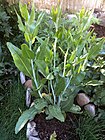Note: This is a project under development. The articles on this wiki are just being initiated and broadly incomplete. You can Help creating new pages.
Difference between revisions of "Lepidium latifolium"
(→Habit) |
|||
| (4 intermediate revisions by 2 users not shown) | |||
| Line 1: | Line 1: | ||
[[File:Lepidium latifolium UGA5477926.jpg|500px|thumb|right|''Lepidium latifolium'']] | [[File:Lepidium latifolium UGA5477926.jpg|500px|thumb|right|''Lepidium latifolium'']] | ||
| − | '''Lepidium latifolium'''normally grows to between 30 centimeters and 1 meter, but may grow as tall as 2 meters. The plants have numerous woody stems, alternating waxy leaves and clusters of small, white flowers | + | '''Lepidium latifolium'''normally grows to between 30 centimeters and 1 meter, but may grow as tall as 2 meters. The plants have numerous woody stems, alternating waxy leaves and clusters of small, white flowers. It has an extensive root network, known to reach 9 feet in depth and constitute 40% of the total biomass of the plant. |
| − | |||
==Uses== | ==Uses== | ||
| − | {{Uses| | + | {{Uses|Liver diseases}}, {{Uses|Kidney diseases}}, {{Uses|Increases cardiac amplitude}}, {{Uses|Decreases frequency rhythm}}, {{Uses|Skin diseases}} |
==Parts Used== | ==Parts Used== | ||
| Line 9: | Line 8: | ||
==Chemical Composition== | ==Chemical Composition== | ||
| − | 500 mg of leaves and roots of plants from all three locations were crushed using liquid nitrogen. Three different leaf positions viz | + | 500 mg of leaves and roots of plants from all three locations were crushed using liquid nitrogen. Three different leaf positions viz. |
<ref name="chemical composition"/> | <ref name="chemical composition"/> | ||
| Line 29: | Line 28: | ||
==Habit== | ==Habit== | ||
| − | {{Habit| | + | {{Habit|Shrub}} |
==Identification== | ==Identification== | ||
| Line 49: | Line 48: | ||
==How to plant/cultivate== | ==How to plant/cultivate== | ||
| − | Salt marshes and wet sands on the south and east coasts. | + | Salt marshes and wet sands on the south and east coasts.<ref name="How to plant/cultivate"/> |
| − | <ref name="How to plant/cultivate"/> | ||
==Commonly seen growing in areas== | ==Commonly seen growing in areas== | ||
| − | {{Commonly seen| | + | {{Commonly seen|Coasts}} |
==Photo Gallery== | ==Photo Gallery== | ||
| Line 64: | Line 62: | ||
==References== | ==References== | ||
| − | |||
<references> | <references> | ||
| − | <ref name="chemical composition">[https://www.ncbi.nlm.nih.gov/pmc/articles/PMC3732271/]</ref> | + | <ref name="chemical composition">[https://www.ncbi.nlm.nih.gov/pmc/articles/PMC3732271/ Chemical composition]</ref> |
| − | <ref name="How to plant/cultivate">[http://www.naturalmedicinalherbs.net/herbs/l/lepidium-latifolium=dittander.php]</ref> | + | <ref name="How to plant/cultivate">[http://www.naturalmedicinalherbs.net/herbs/l/lepidium-latifolium=dittander.php Cultivate]</ref> |
| − | |||
<ref name="Leaf">[http://www.efloras.org/florataxon.aspx?flora_id=5&taxon_id=242420054 Botanical description]</ref> | <ref name="Leaf">[http://www.efloras.org/florataxon.aspx?flora_id=5&taxon_id=242420054 Botanical description]</ref> | ||
| − | |||
| − | |||
</references> | </references> | ||
Latest revision as of 15:33, 1 June 2020
Lepidium latifoliumnormally grows to between 30 centimeters and 1 meter, but may grow as tall as 2 meters. The plants have numerous woody stems, alternating waxy leaves and clusters of small, white flowers. It has an extensive root network, known to reach 9 feet in depth and constitute 40% of the total biomass of the plant.
Contents
Uses
Liver diseases, Kidney diseases, Increases cardiac amplitude, Decreases frequency rhythm, Skin diseases
Parts Used
Chemical Composition
500 mg of leaves and roots of plants from all three locations were crushed using liquid nitrogen. Three different leaf positions viz. [1]
Common names
| Language | Common name |
|---|---|
| Kannada | NA |
| Hindi | Cansur, Chausaur |
| Malayalam | NA |
| Tamil | NA |
| Telugu | NA |
| Marathi | NA |
| Gujarathi | NA |
| Punjabi | NA |
| Kashmiri | NA |
| Sanskrit | NA |
| English | Perennial pepperweed, Tall whitetop |
Properties
Reference: Dravya - Substance, Rasa - Taste, Guna - Qualities, Veerya - Potency, Vipaka - Post-digesion effect, Karma - Pharmacological activity, Prabhava - Therepeutics.
Dravya
Rasa
Tikta (Bitter)
Guna
Laghu (Light)
Veerya
Vipaka
Karma
Prabhava
Habit
Identification
Leaf
| Kind | Shape | Feature |
|---|---|---|
| Simple | Rosette leaves are long petiolate. Cauline (stem) leaves are alternate, 1-3 in. (2.5-7.6 cm) long and oblong. |
Flower
| Type | Size | Color and composition | Stamen | More information |
|---|---|---|---|---|
| Unisexual | Many | Flowering occurs in the late spring to summer, when flat, dense clusters of flowers develop at the apex of the flowering stem. Individual flowers are 4-petaled and white. |
Fruit
| Type | Size | Mass | Appearance | Seeds | More information |
|---|---|---|---|---|---|
| 4-5 cm long | The fruit is a round to oval hairy capsule that is 0.06 in. (1.5 mm) in diameter. It contains a single seed. | {{{6}}} |
Other features
Where to get the saplings
Mode of Propagation
How to plant/cultivate
Salt marshes and wet sands on the south and east coasts.[3]
Commonly seen growing in areas
Photo Gallery
References
External Links
- Ayurvedic Herbs known to be helpful to treat Liver diseases
- Ayurvedic Herbs known to be helpful to treat Kidney diseases
- Ayurvedic Herbs known to be helpful to treat Increases cardiac amplitude
- Ayurvedic Herbs known to be helpful to treat Decreases frequency rhythm
- Ayurvedic Herbs known to be helpful to treat Skin diseases
- Herbs with Leaves used in medicine
- Herbs with Root used in medicine
- Herbs with Seeds used in medicine
- Herbs with common name in Hindi
- Herbs with common name in English
- Habit - Shrub
- Index of Plants which can be propagated by Seeds
- Herbs that are commonly seen in the region of Coasts
- Herbs
- Pinaceae
- Himalaya




